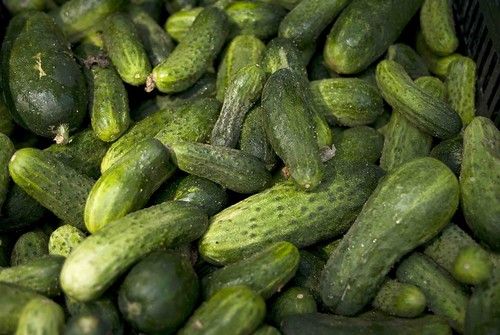Tip of the Week: The Versatile Cucumber
Posted in Gardening Tips on August 24 2009, by Sonia Uyterhoeven
 |
Sonia Uyterhoeven is Gardener for Public Education. Join her each weekend for home gardening demonstrations on a variety of topics in the Home Gardening Center. |
 Last week I told you of the nutritional merits of beets. Cucumbers can’t make the same clame to nutrition—there is a small amount of vitamin C in a cucumber, but aside from that it is mostly water.
Last week I told you of the nutritional merits of beets. Cucumbers can’t make the same clame to nutrition—there is a small amount of vitamin C in a cucumber, but aside from that it is mostly water.
But don’t despair. Cucumbers often show up in face creams, and you’ve no doubt seen the stereotypical facial with two slices refreshing and covering eyes. Cucumbers with their softening, beautifying, and anti-irritant properties have swept the cosmetic world by storm.
For me, cucumbers remind me of my youth. With my childhood culinary bible, The Joy of Cooking, in hand, I set about in late summer to make my annual batch of pickles, with varying rates of success. I took great pride in growing the pickling cucumbers from seed and then seeing them find their rightful place in the cupboard in a jar surrounded by cider vinegar, dill seed, and garlic.
My sister has one of the best smoothie blender, she would toss cucumbers into the blender to whip up her daily cup of gazpacho. The English serve them for high tea in all their simplicity, lightly salted on open-faced sandwiches with mayonnaise or butter. They are an indispensable part of any good crudités.
There are many types of cucumbers for the home gardener to try. There are fancy heirloom cucumbers such as ‘Lemon’, which looks like a strange hybrid between a lemon and a cuke; pickling cucumbers that range from the size of a cornichon to a 6-inch long spear; Burpless varieties with thin skins and mild flavor that are easier to digest; and Asian varieties that are sweet and long with tiny seeds.
If you are trying to decide between growing a slicing (salad) cucumber and a pickling cucumber but only have space in the garden for one variety, know that pickling cucumbers make excellent slicers and slicing cucumbers can be made into pickles. However, you will need to decide how much space you will dedicate to them. Many of the vining cucumbers easily spread 6–8 feet while the more compact bush varieties cover a 2- to 3-foot area. Bush cucumbers, such as ‘Spacemaster’, ‘Salad Bush’, ‘Bush Champion’, and ‘Parks Bush Whopper’ are ideal for containers. Containers should be at least 12 inches deep and will need to be fertilized every 2 weeks with a fish emulsion.
Bush and pickling cucumbers are happy sprawling on the ground. I used to grow my pickling cucumbers in a corner of my vegetable garden where I would make three “hills” or mounds of soil several feet apart and plant them 5 or 6 seeds (thinning out to the three strongest plants). Remember to mulch the area with straw or a salt marsh hay substitute when you are growing cucumbers on the ground to protect the fruits.
It is best to use a trellis when growing vining cucumbers. Trellises will not only minimize the amount of space needed for large vines, they will also ensure that the large slicing or Asian cucumber you might grow will stretch downward and form an elegant, straight fruit.
We have grown cucumbers up bamboo teepees and over A-frames and wire trellises. Even though the cucumbers have tendrils, you will have to give them extra support by tying the stems to the structure with either twine in a figure eight configuration or with Velcro plant ties. If using a trellis, space plants approximately 10 inches apart.
Cucumbers are indigenous to India. This tells you right off that they relish warm temperatures. They will collapse at the sight of frost, so wait until your last frost date has passed before you step out into the garden with your seeds or transplants. The seeds are large and a joy to plant. If you are impatient by nature you can start them indoors 3 weeks earlier, but don’t let them hang around too long in small pots.
Cucumbers will grow faster and taste better if you have enriched your soil with compost or good organic matter. Some of the expert growers maintain that adding dried seaweed to the soil to boost trace elements will give you stronger and better disease-resistant plants. Cucumbers like good nitrogen levels and do well if they are preceded by an early pea crop.
Mulch around your plants to protect their shallow roots and to keep moisture levels high: Cucumbers need plenty of water to grow well. Plant them in the full sun in northern climates and give them some protection from the baking afternoon sun in southern regions.
Cucumbers are either monoecious or gynoecious. Monoecious means that the plant has both female flowers that fruit and male flowers that provide the pollen. Insects will come and move the pollen around so that you get a nice harvest. Gynoecious plants are all female. They produce large, early crops of cucumbers but they need to be planted near a monoecious cucumber to be pollinated. Seed packets will contain seed for a few of these pollinator plants that are colored so you can identify them. Make sure you label them in your garden so they are not accidentally removed.

